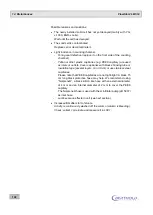
FlowStar2 LB 514
13. Explanations
117
group is defined by the length of the basis time interval. A maxi-
mum of 8 groups will be formed (see table 2, column 2), always
starting with the counts measured last. Since the basis time in-
terval is max. 16 seconds long (see table 1), all counts of the last
128 seconds (128 = 8 x 16) will be summarized in groups in this
case.
Peak half- width
Basis time in-
terval
4
1
8
2
15
4
30
8
60
16
Table 1
One should also keep in mind that the number of counts in the
groups may change every second, since a new second interval
will be added and the one stored 128 seconds ago will be re-
jected. The counts change in one-second intervals even if the
basis time intervals are longer than 1 second. Averaging over
several second intervals results in a significant smooth of the var-
iations.
The further procedure for calculating a smoothed average value
always proceeds from the counts in these groups.
By entering one time constant one defines how many basis time
intervals with their counts are to be used for averaging. The time
constants 0.5, 1.0, 1.5 and 2.0 are available. Table 2 shows that
2, 4, 6 or 8 basis time intervals will then be used. Since one basis
time interval is about equal to one quarter of the peak half-width,
this means that the average is calculated over half, one, one and
a half or two peak half-widths (the time constant is indicated in
peak half-widths).














































